Events
The “UFOs are real” documentary that Walt Disney Studios almost made
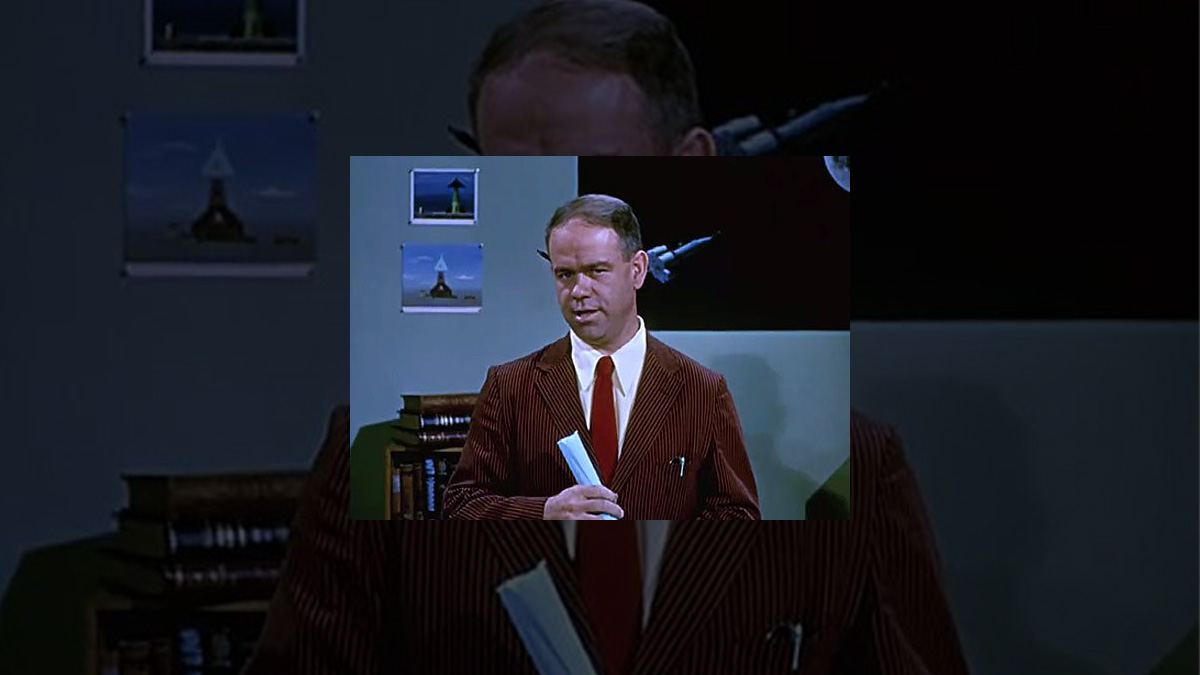
I have long been a fan & supporter of Didier Ghez‘s
“Walt ‘s People” books, that series of paperbacks which collects amazing
interviews with Disney Legends. But with Volume 11
of this series, Ghez has truly out-done himself. This 630-page book
features 36 separate interviews which have been done by some of the top
animation & theme park historians working today (EX: John Canemaker, John
Culhane, Christopher Finch, J.B. Kaufman, Jim Korkis and Dave Smith, among
others).
“So what’s the very best story to be found in Volume 11?,”
you ask. For my money, it would have to be John Canemaker’s March 1998
interview with Ward Kimball. Where this Disney Legend then went on the record about
that aborted “UFOS are real” film which Walt Disney Studios was
supposed to have produced in the mid-1950s with the U.S. Force’s help
As the story goes, Kimball
had been working with Wernher von Braun on three space-themed episodes
of the
“Disneyland” television series. And this outer space documentaries had
been proven to be so popular with the public (i.e. When the first film in this
trio — “Man in Space” — aired in March of 1955, it was viewed by
over 42 million people) that they have since been credited with unofficially kick-starting
America’s efforts to enter the space race.

Disney Legend Ward Kimball introducing the “Man in Space” episode of the “Disneyland”
TV series. Copyright Disney Enterprises, Inc. All rights reserved
Which (as Kimball recounted to Canemaker) …
… did not go unnoticed by Al Meyers and (Edward) Heinemann, two big
shots in Douglas Aircraft, plus George Hoover, who was head of the office of
naval research. (They) came to me and wanted Disney to do a UFO picture.
(These three) all knew that UFOs were for real. They had proof, they had
everything. And I said, “Sure.” I’d been collecting material on UFOs for years
anyway, and I had a cupboard full of stuff there. Every report and all the
books, you name it. I was a student of Charles Ford, and that was my dream to
end the (“Disneyland” television series of outer space documentaries)
with (a fourth film about UFOs).

The saucer-like craft that man would supposedly use to reach the Red Planet in the
“Mars and Beyond” episode of the Disneyland television series. Copyright
Disney Enterprises, Inc. All rights reserved
Walt sort of went along with it. But we never had any payoff
footage. You’ve got to end up that last ten minutes with some real stuff.
Our disappointment came when we talked to Colonel Miranda
from the Wright-Patterson [Air Force Base]. Bill Bosché (i.e. the writer that
Walt had assigned to work with Ward on these outer space documentaries for the
“Disneyland” television series) never believed in UFOs even though
Clyde Tombaugh, the guy that discovered the planet Pluto, had seen four or five
in Arizona …
So we’re having lunch with this Colonel Miranda over in the commissary, and he,
at Wright-Patterson, had all the footage shot from fighter pilots, everything,
and most of it classified. He told us what we could have for our picture and
what we couldn’t have.
And so Bosché … He gets a smile on his face and he says, “What about flying
saucers? I don’t suppose you have anything on that?” (And then Miranda replies by saying) “Oh,
hundreds of feet!” (And) Old Bosché looked like he’d faint.

I don’t think that these are the sorts of flying saucers that Bill Bosché was talking about.
Copyright Disney Enterprises, Inc. All rights reserved
(The Colonel continues by saying) “We’ve got all sorts of
film that we can’t show you, it’s secret, and it’s going to remain classified
until we can take one apart and analyze it.”
And he [Bosché] says, “Well, how come?” And that’s when (Miranda) taught us our
lesson, he says, “Look! Everyone would ask the Air Force, ‘What are these
things?’ And if we couldn’t answer that question, we would be in trouble. We
could have a war start. They would accuse the Russians of doing it, they’re
ahead of us.” He went through a whole line of reasons why this couldn’t be
divulged.
(Which was endlessly frustrating for Kimball. Since the
Colonel then went on to say that) “We
have shots (of UFOS) taken from gun cameras, we have beautiful footage. We’ve
got ’em all shapes and size, port holes, lights … (But) We don’t know what they are yet. Until
we can dissect (one), and give a reasonable explanation without our society
coming unglued, we can’t. It’s going to remain classified.”

Are these Egyptian hieroglyphics depicting unidentified flying objects?
Which kind of drove Kimball nuts. Given that Ward had already done a lot of the
research necessary for this proposed fourth outer space documentary for the
“Disneyland” TV series. As
Kimball recalled to Canemaker:
And I had everything up to the last ten minutes (of that
show) … We had these drawings that people have made (of) the spaceships that had passed for a good part
of a day over the Egyptian army in Egypt in 2000 B.C. They described the stench
and the fumes, the whole thing; it was even done in hieroglyphics. We wanted to
bring that to life (through animation). Great thing, you know. Pictorially, it (would
have been) a wonderful thing to do.
But without the last 10 minutes of that show, which was to
have featured the Air Force’s footage proving that UFOs were in fact real …
This proposed fourth installment of the outer space documentary series just had
no pay-off.

Ward shows Walt a model of the saucer-shaped craft which will be featured in
“Mars and Beyond.” Copyright Disney Enterprises, Inc. All rights reserved
Which isn’t to say that all of that prep work that Ward had
done on this “UFOs are real” show went to waste. As Kimball pointed
out to Canemaker in that 1998 interview:
You noticed on the (“Mars and Beyond”) show I got
in the saucers at the end.
But even so, as you read this interview in Volume 11 of
“Walt’s People: Talking Disney with the Artists who knew him”
(Xlibris Corp, September 2011), you can sense Ward’s frustration. Especially
since — in the years that followed Colonel Miranda’s refusal to release that
footage …

Air Force officials at a Project Bluebook press briefing in the late 1950s
The Air Force spent millions of dollars, hundreds of
thousands of dollars on Project Blue Book, to pooh-pooh UFOs.
And I had everything (I needed) up to the last ten minutes
(of this show).
Which isn’t to say that Ward didn’t get to meet some pretty
out-of-this-world characters during the 88 years that he spent on this
planet. Take — for example — Kimball’s
close encounter with “Captain EO” himself, Michael Jackson. Which all came about because …

Copyright Sony Inc. All rights reserved
… my daughter (Kelly) was the costume designer (on) Thriller. John Landis was the director (on
this music video) and the first day (of production Michael asks) “Who’s doing
the costume?” John says, “Why you should meet her. You’re always talking about
Ward Kimball. She’s Ward Kimball’s daughter.”
(Jackson then says) “Wow!” So he goes over and introduces (himself) to Kelly.
She did all that ghoul stuff (on “Thriller”). And (Jackson) said he’d
like to meet me. (My daughter) thought he was bull$#itting. So did I when she
came and told me.
But no (Michael came to my house) with a driver in his
Bentley parked out in front. Came in and just wanted to talk about Walt. Cause
he had all this state-of-the-art motion picture 35mm theatre. He had all the
Disney films and he’d go in there to look at them.

Ward Kimball, Michael Jackson and Betty Kimball during the King of
Pop’s 1982 visit to Grizzly Flats.
And he showed (my wife Betty, Kelly and myself) his whole
place. That was before he moved off to the ranch. We went out there and had no
booze, no smoking, sat at this long table, banquet table set for twenty-five
people. So he sets me at the end, Betty on my left, couple of his friends and
he on the left side. I would feel I was being looked at and I’d look at him and
he’d be staring at me. We’d make eye contact and he’d just say, “Ward Kimball.”
No kidding!
What else did Ward remember about the times that he spent
with the “… Quiet. Whispery …” King of Pop? As part of Volume 11
of “Walt’s People,” Kimball suggests that Canemaker talk with Frank
Thomas about …
… what happened the time we went out (to Neverland Ranch)
with our wives. Blinking lights in the trees just like Disneyland. He’s in love
with the place.

The Disneyland-inspired train station at Neverland Ranch
These are the sorts of stories that you’ll only uncover by
reading the interviews which have been collected in this amazing set of
paperbacks. And with Volume 12 of the “Walt’s People” series
reportedly already in the works … If you haven’t yet started reading these
books, you’d best get started. Otherwise you’ll really be missing out on an
out-of-this-world collection of stories that come directly from a group of
Disney Legends who actually worked with Walt.
Your thoughts?
Events
From toxic gas leaks to the triumph of ‘Finding Dory,’ Lindsey Collins has loved every minute of her time at Pixar Animation Studios

When it comes to “Finding Dory” producer Lindsey Collins, she takes “going-with-your-gut” to a whole new level.
To explain: This Occidental College graduate joined Walt Disney Animation Studios straight out of school in 1994. And after working as a PA on “Pocahontas” & “The Hunchback of Notre Dame,” Lindsey had just been made assistant production manager on “Hercules” when she began hearing people talk about Pixar.
“I was working at Disney with Ron & John (Author’s note: That’s Ron Clements & John Musker, the acclaimed animation directing team behind not only “Hercules” but also “The Little Mermaid,” “Aladdin” and WDAS’ soon-to-be-released “Moana”) and was really enjoying that experience. But just before ‘Toy Story’ came out, there was a brief blurb in the company newsletter about Pixar. And I was like ‘Well, who are these guys?’ And then I got to meet John Lasseter and was just totally blown away by what he and his team were doing,” Collins recalled during a recent phone interview.
 Lindsey Collins. Copyright Disney Pixar
Lindsey Collins. Copyright Disney Pixar
“Anyway, Disney liked what I was doing at Feature Animation and really wanted me to stay on there. So they offered me a contract. And I was like ‘I’m fine. I can stay here.’ So I signed that contract. And then I went home and threw up all night,” Lindsey laughed. “The very next day, I went back into Disney and said ‘I’m sorry. I can’t do this. I really have to go.’ Then I went up to the Bay area and basically pounded on Pixar’s door & said ‘please, please, please hire me.’ “
Luckily for Ms. Collins, Pixar Animation Studios was just in the process of gearing up to do “A Bug’s Life.” More to the point, Sharon Calahan – the director of photography on that production – saw lots of potential in this recent Mouse House escapee.
“Sharon was hugely involved with Pixar’s decision to hire me. And part of that was because I had worked with background painters while I was at Disney Feature Animation. So even though I had no clue how CG worked at that time, I could talk with Sharon in the terms of painting. And she was like ‘That’s exactly how I want people around here to start thinking when it comes to how we light our scenes,’ ” Collins continued.
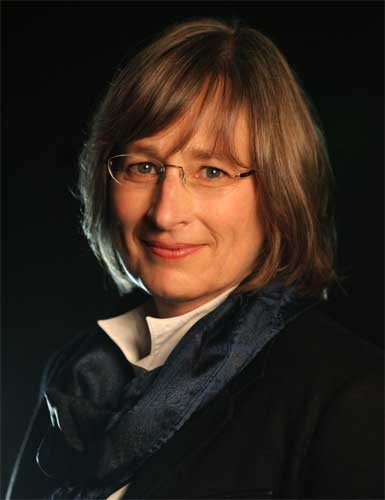 Sharon Calahan. Copyright Disney Pixar
Sharon Calahan. Copyright Disney Pixar
“Mind you, I was the one who kept telling Sharon ‘I don’t know how helpful I can be to you guys. Because I really don’t understand a lot of what you’re saying when it comes to CG.’ But she wouldn’t give up on me. Sharon kept insisting that – because I had already worked with artists and knew how to communicate a vision for a painting – I was also going to be able to communicate with software engineers. It was just a matter of learning a new language. Sharon was instrumental in convincing me that I had any right to be at Pixar,” Lindsey stated.
Which isn’t to say that life was initially easy for Collins at Pixar. First there was that steep learning curve which came with her new job (“When I first got here, I had no idea what a render farm was. I was like ‘There’s a farm? Like a petting zoo?’ “). Then there was the fact that the Port Richmond office park which housed this animation studio at that time was downwind of a Chevron plant (“Sometimes – because there’d be explosions or gas leaks at that plant — we’d then be told to shelter in place or to not come into work at all that day. We used to call those toxic snow days”).
But even under these somewhat stressful & occasionally toxic conditions, Lindsey thrived. Largely because she really loved her new co-workers at Pixar (“They were people who could really make me laugh. In a way I didn’t know that real adults / professionals could make me laugh. And I feel like I haven’t stopped since I got here”).
 Copyright Disney Pixar
Copyright Disney Pixar
But it hasn’t all been big laughs. Take – for example – what happened when Ed Catmull, the president of Pixar Animation Studios, approached Collins (who was producing “Finding Dory” at that time) about a change that he wanted to make to that Andrew Stanton film.
“Pixar had this new renderer that it wanted to try out. And Ed felt ‘Dory’ would be the perfect project to try this new technology on. The only problem was that – when Ed approached me – we were already well into production on this ‘Finding Nemo’ sequel. Which meant – if we were going to take full advantage of what Ed was offering us – we’d then have go back and redo a bunch of stuff we’d already done on this movie,” Lindsey said.
“But the good news was – because “Dory” was a sequel to “Nemo” – we weren’t discovering a look for this movie. We were just trying to improve on it,” Collins continued. “And that was the handshake deal that Ed was offering. That – if we agreed to use this new renderer plus some new lighting & shading tools. Basically reinventing the entire back end of the Pixar production line – we’d then end up with a far better looking film that was still set in the same world as ‘Nemo.’ As long as the studio delivered on that promise, Andrew was willing to go for it. Mind you, it would be another full year before Andrew would then actually get to see any footage that this new renderer produced. So it was a huge leap-of-faith on his part. But Andrew was incredibly excited when the redone ‘Dory’ footage began coming in and it all looked so great.”
 Copyright Disney Pixar
Copyright Disney Pixar
Another technology challenge that Lindsey had to deal with while producing this “Finding Nemo” sequel was Hank the septopus. But in this case, as soon as Collins saw this character described in an early draft of Stanton’s ‘Dory’ script, she immediately got Pixar’s character department involved.
“When you’re working as a producer, you get to see pages a lot earlier than the rest of the crew. And as soon as I read that first scene with Hank, I turned to Andrew and said ‘Just how big a character are we talking here?’ And he said ‘I think it’s a pretty big role.’ And I was like ‘Okay.’ And I then went down to the character department and told them that Andrew wanted to add an octopus to the cast. And they all went kind of pale,” Lindsey said. “I think what they knew right-off-the-bat that – if we were going to do an octopus in the ‘Nemo’ / ‘Dory’ world with all of the realism & beauty that entails and then have that character fit in – it was going to be incredibly difficult if not kind of impossible to pull that off. Largely because the character of Hank couldn’t be super-cartoony.”
“I mean, on ‘Finding Nemo,’ we had had Pearl, the little octopus who was in Mr. Ray’s class. But clearly the whole point of a character like Hank was that he needed to be a jack-of-all-trades. That this character was going to have to be able to get in & out of everything. So the character department knew – right off the bat – that this was going to be something that would kind of break the bank, if you will,” Collins continued.
 Copyright Disney Pixar
Copyright Disney Pixar
“Now what you have to understand about Pixar is that we play ‘Chicken’ a lot here. By that I mean, we see how long we can let something sit on the page before we then have to finally move it into production. But when it came to Hank, that just wasn’t an option,” Lindsey stated. “Based on this character’s needs, Hank was going to take every minute we had, all the time between when he first appeared in Andrew’s script and when we’d be in full production on ‘Dory’ to build this. So we needed to commit very early on this character. But the good news is that I think we bet right on Hank. He actually wound up being a far bigger character in this film. And I think that was partially because the technology which drove this character was so cool.”
So how did it feel – after five years of hard work – to have “Finding Dory” become this hugely popular motion picture? The fifth animated film in all of Hollywood history to earn over a billion dollars at the worldwide box office? Collins – the mother of three – put a somewhat maternal spin on her reply.
“You have to understand that – when you work on projects like ‘Dory’ or ‘John Carter’ for as long as Andrew and I did – these movies are kind of like your kids. In that they then go off & have their own successes & failures which are kind of beyond your control as a parent,” Lindsey said. “But as you’re finishing up working on a film, emotions do sometimes well up at the weirdest time.”
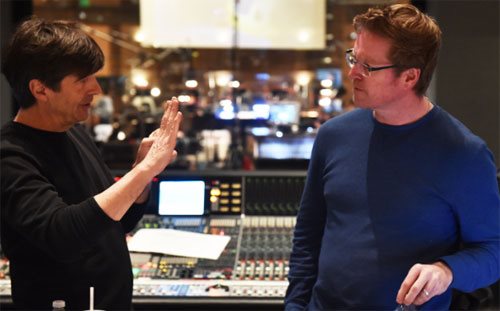 Thomas Newman (L) and Andrew Stanton in the booth during the recording sessions for “Finding Dory” ‘s score. Copyright Disney Pixar
Thomas Newman (L) and Andrew Stanton in the booth during the recording sessions for “Finding Dory” ‘s score. Copyright Disney Pixar
Take – for example – what happened while Collins & Stanton were sitting in the recording booth as Thomas Newman rode herd on “Finding Dory” ‘s scoring sessions.
“We’d had this huge orchestra for four days. And then – on the last day – Tom cleared the stage and recorded the scene where Nemo, Marlin & Dory reunite in the pipes under the Marine Life Center. Now you have to understand that this is one of the only times in his score for ‘Finding Dory’ that Tom reprises a cue from “Finding Nemo.’ And he has this single clarinet – or was it an oboe? – play that cue,” Lindsey recalled. “And as this was happening, Andrew got really quiet. He was just sitting there, watching.”
“So I went up to him and said ‘What’s going on? How are you feeling about all this?’ Because we were finishing this film up at that time. And Andrew looked at me and he was really emotional. And then he said “I remember the first time I wrote Dory’s name on a piece of paper. I can’t believe how far she’s come.’ And that’s when I started getting emotional too, ” Collins said.
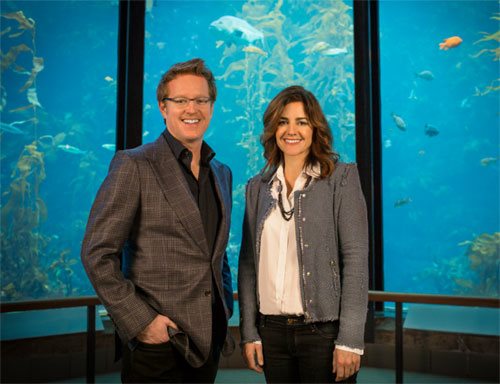 Andrew Stanton & Lindsey Collins. Copyright Disney Pixar
Andrew Stanton & Lindsey Collins. Copyright Disney Pixar
And speaking of ” … how far she’s come,” one might say the same thing about Lindsey. Who – it should be noted here – when she was studying at Occidental College 25 years ago, didn’t major in business or film studies. But – rather – diplomacy and world affairs.
“Those diplomacy skills do actually come in handy when you’re working on a movie. But you want to honestly know the very best thing you can do at college if you eventually hope to become a producer? Work as an RA,” Collins concluded. “Katherine Sarafian – who’s also a producer here at Pixar — also ran a dorm while she was in college. And the two of us agree that that job was great training for becoming a producer. When you’re constantly dealing with people and have to get answers to ridiculous questions like ‘Okay, who pooped in the closet?’ “
The Blu-ray & DVD version of Pixar’s “Finding Dory” hits store shelves today.
This article was originally published by the Huffington Post on Tuesday, November 15, 2016
Events
Women in Animation panels prove that there’s more to San Diego Comic-Con than just promotion of pop culture
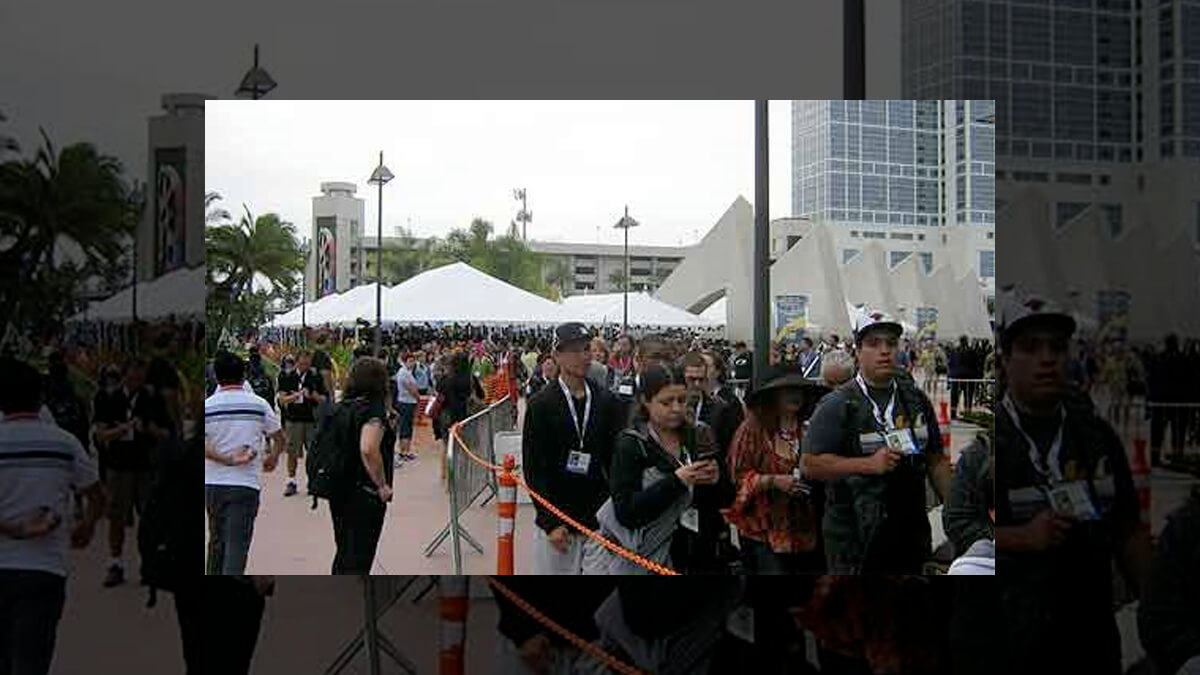
Thanks to Comic-Con International, now through Sunday, San
Diego is the white-hot center of the pop culture universe.

Photo by Jim Hill
Mind you, there’s more to this four day-long event than
those high-profile presentations in Hall H. Which is where various movie
studios will be parading celebrities & showing exclusive clips. All with
the hope that those 6000 early adopters who have (some of them, anyway) been
camped out in this cavernous convention center for hours ahead of time will
then hop on social media and start evangelizing about how cool that footage
from next summer’s would-be blockbuster looked.
But if you can look past those long lines for
limited-edition merchandise and/or the tens of thousands of people who are
cosplaying, you’ll see that there’s another, more serious side to Comic-Con
International. And that’s the part of this four day-long event which allows a lot
of creatives to reconnect with one another.
Take – for example – Marge Dean, the general manager of
Stoopid Buddy Stoodios (i.e., that Burbank-based operation which is responsible
for “Robot Chicken,” television’s longest-running stop motion series, as well
as Sony’s just-about-to-begin-production-on-its-second-season-for-Crackle
superhero spoof, “SuperMansion”). Over the past decade, she’s made at least
eight trips down to San Diego for Comic-Con International. And what Marge loves
most about this four day-long event is all of the old friends she invariably
runs into as she’s coming & going from the convention center.

Photo by Jim Hill
“Whenever I’m down in San Diego for Comic-Con, I just love
the experience of getting outside the hall, walking down the street and then
suddenly going ‘It’s you ! A guy I haven’t seen in three years ! How are you
!,” Dean recalled during a recent phone interview. “Even though I really don’t
like driving to Comic-Con – which is why, these days, I always take the train
down from LA – I really enjoy strolling around San Diego and then running into
people that I haven’t seen for a long, long time.”
Mind you, Marge is sure to run into a lot of people that she
knows / has previously worked with today in Room 24ABC at the San Diego
Convention Center. That’s because this is where Comic-Con’s “Cartoon Creatives:
Women Power in Animation” panel will be held starting at 4:30 p.m. PT. And
joining Dean at this gathering (which will be shining a spotlight on Women in
Animation‘s goal to have a 50/50 workforce by 2025) will be a veritable who’s
who from the worlds of television & feature animation.
Among those who are scheduled to appear today are:

Daron Nefcy, the creator / executive producer of “Star vs. the Forces of Evil.”
Copyright Disney Enterprises, Inc. All rights reserved
-
Lauren Faust (the creator of “My Little Pony:
Friendship is Magic”) -
Brooke Keesling (the director of animation
talent development at Disney TV Animation) -
Katie Krentz (the senior director of development
at Cartoon Network) -
Lauren Montgomery (the co-executive producer of
“Voltron: Legendary Defender”) -
Daron Nefcy (the creator / executive producer of
“Star vs. the Forces of Evil”) -
Gina Shay (the producer of DreamWorks
Animation’s “Trolls”) -
Stevie Wermers-Skelton (the co-director of
Disney’s upcoming “Frozen” holiday special)
Dean (who serves as the co-president of WIA) views this
hour-long session (which will be moderated by Leslie Combemale of Animation
Scoop) as a great example of a lesser known aspect of Comic-Con International.
Which is the many ways that this four day-long event educates the fan
community. Gives them a clearer understanding of what’s really going on in
today’s entertainment world.

Marge Dean, co-president of Women in Animation, speaking at a WIA event
honoring Nickelodeon’s contributions to television animation.
“I mean, did you know that women hold only 20% of the
creative roles in today’s animation industry? While the landscape has obviously
changed over the 20+ years that I’ve worked in this field, women still predominantly
work on the management side of animation. Not the creative end of things,”
Marge continued. “That’s a big part of what the Women in Animation organization
is all about. More to the point, why we’re doing outreach to the fan community
at Comic-Con this week. We’re looking to shine a spotlight on this disparity in
the industry and hopefully create some opportunities for more women to break
through creatively in the future.”
Of course, in order to know where you are (more importantly,
where you’re headed next), it helps to have to have a firm understanding of
where you’ve been. Which is why WIA will be holding a second panel at Comic-Con
International, “She Made That? Nickelodeon hosts Women in Animation.” This
presentation (which will also be held in Room 24ABC from 6:30 – 7:30 p.m. PT on
Friday, July 22nd) will honor some of the real pioneers of
television animation. The women who helped create such memorable Nicktoon
series as:
-
Vanessa Coffey (“The Ren & Stimpy Show,”
“Rugrats” & “Doug”) - Mary Harrington (“Invader Zim,” “Hey Arnold!”)
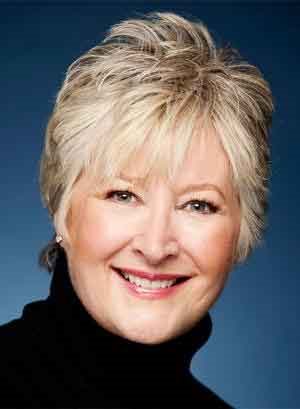
Television animation pioneer Margaret Loesch
Of course, Coffey was quick to credit the woman who gave her
a leg up when she was just getting her start in animation in the early 1980s.
And that was Margaret Loesch, the then-President and CEO of Marvel Productions.
“At that time, Margaret was the only woman working in
television animation. I was just this intern, working down the hall from Stan
Lee. But Margaret took a chance on me,” Vanessa remembered. “And Margaret not
only mentored me, she genuinely inspired me. I mean, here she was running this
huge production company in a field that was mostly run by men. Margaret proved to
me that not only should women in the animation business but that they could be
these huge successes.”
You see? That’s what’s really great about Comic-Con
International. If you can just get past all of the hype (not to mention handle those
super-crowded conditions you’ll encounter out on the show floor), you might
then discover that some real education has been mixed in with your
entertainment.

(L to R) Vanessa Coffey, Stephen
Hillenburg (the creator of
“SpongeBob SquarePants”) and and Butch Hartman (the
creator of “The Fairly Oddparents.”
Comic-Con International is running at the San Diego
Convention Center now through Sunday, July 24th.
This article was originally posted on the Huffington Post’s Entertainment page on Thursday, July 21, 2016.
Books & Print
It’s Jim Hill in the Restaurant with the Book – The Jungle Book – and You Can Join Him June 5th
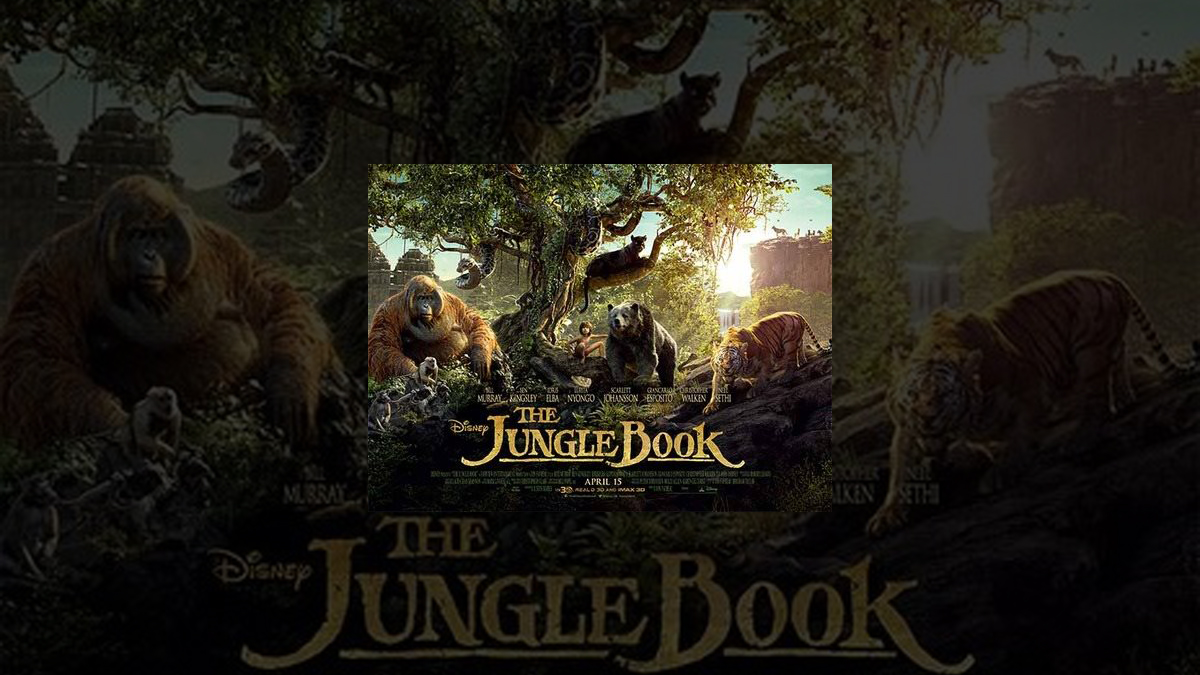
It’s a Jungle (Book) Out There

For more than 50 years, The Walt Disney Company has been reimagining the writings of Rudyard Kipling–taking his tales of Mowgli the man-cub and his animal friends and then turning them into hugely popular films and television series.

Let Jim Hill take you from Bill Peet’s far-too-dark take on this tale (which Walt Disney just hated) to Jon Favreau’s photo-realistic box office smash (for which the Studio is already developing a sequel).
You’re sure to go ape as you listen to all of these great behind-the-scenes show business stories.
Join us June 5th, 2016 from 11:30 AM-1:30 PM at HB Burger, 127 West 43rd Street in New York City
Tickets are $62.00: Each ticket includes lunch at HB Burger, the program, and a special souvenir.
Buy tickets now on line here –> Unofficial Guide’s Disney Dish site or here –> e.t.c. (events — tailor made & customized)
Get your tickets now!
email events@etccustomevents.com with any additional questions.
-

 Film & Movies7 months ago
Film & Movies7 months agoBefore He Was 626: The Surprisingly Dark Origins of Disney’s Stitch
-

 History5 months ago
History5 months agoCalifornia Misadventure
-

 History10 months ago
History10 months agoThe Super Bowl & Disney: The Untold Story Behind ‘I’m Going to Disneyland!’
-

 Television & Shows11 months ago
Television & Shows11 months agoHow the Creators of South Park Tricked A-List Celebrities to Roast Universal – “Your Studio & You”
-

 Film & Movies6 months ago
Film & Movies6 months agoThe Best Disney Animation Film Never Made – “Chanticleer”
-

 Theme Parks & Themed Entertainment5 months ago
Theme Parks & Themed Entertainment5 months agoThe ExtraTERRORestrial Files
-

 History6 months ago
History6 months agoWhy Disney’s Animal Kingdom’s Beastly Kingdom Was Never Built
-

 Television & Shows7 months ago
Television & Shows7 months agoThe Untold Story of Super Soap Weekend at Disney-MGM Studios: How Daytime TV Took Over the Parks






